February 10th, 2016
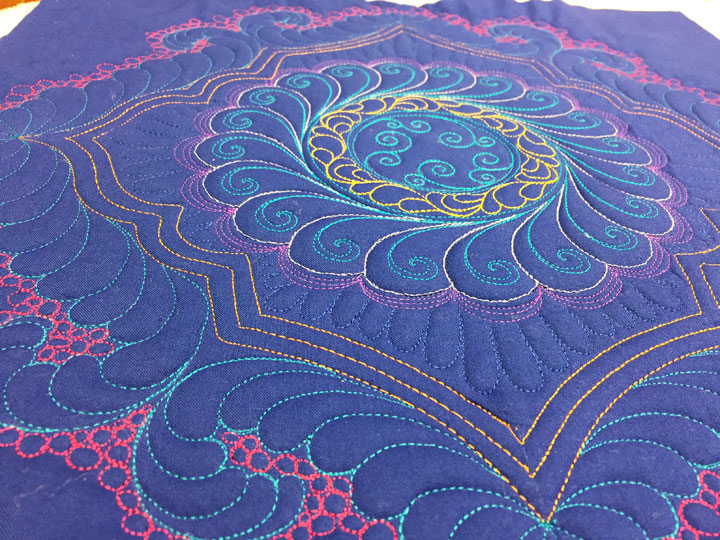 I’ve done previous blog posts about creating fancy frame designs but this one is a bit different. In this case, I created a curvy/wurvy frame using ruler work, and then I embellished it heavily with plumes. My photos did not come out so great, but they are all that I have to illustrate the process, so we’re going to need to make do. This is the final piece:
I’ve done previous blog posts about creating fancy frame designs but this one is a bit different. In this case, I created a curvy/wurvy frame using ruler work, and then I embellished it heavily with plumes. My photos did not come out so great, but they are all that I have to illustrate the process, so we’re going to need to make do. This is the final piece:
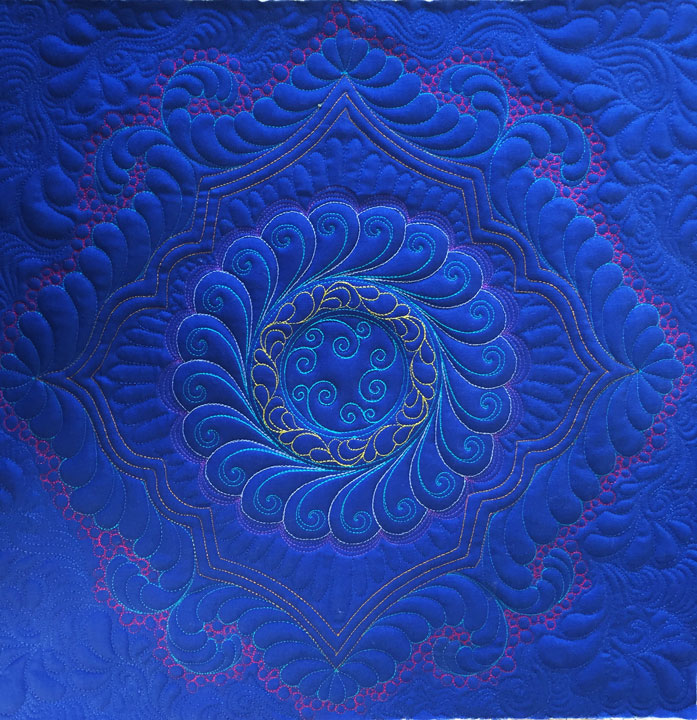 To make a fancy frame for the feathered wreath, I started with the Turrets 3 ruler. I’ll be blogging more about turret rulers, but they are basically a family of rulers that were designed primarily to create really beautiful swag border types of designs, but they also work great for creating fancy frames. Here is a shot of what the Turrets 3 ruler that I used for this design looks like:
To make a fancy frame for the feathered wreath, I started with the Turrets 3 ruler. I’ll be blogging more about turret rulers, but they are basically a family of rulers that were designed primarily to create really beautiful swag border types of designs, but they also work great for creating fancy frames. Here is a shot of what the Turrets 3 ruler that I used for this design looks like:
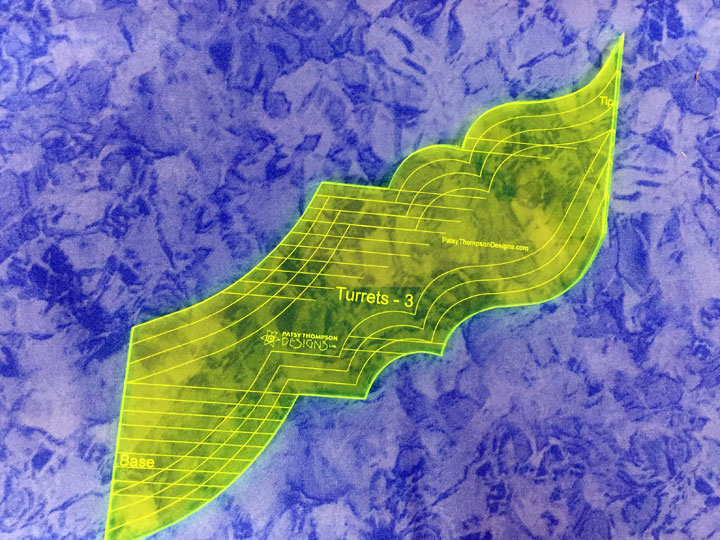 (I’m hoping to have these available in the store in the next week or so, but we’ve gotten kind of distracted by some family emergencies, so we’ll see.) The left and right sides of the ruler are essentially “positive” and “negative” cutouts of the same shape. The ruler has etched lines so you can create a series of channels and there are other series of lines that allow you to accurately “keep your place” when you move the ruler to stitch the opposite side of the swag or frame. Anyway, this next photo shows the most basic “bones” of the frame stitched around the wreath:
(I’m hoping to have these available in the store in the next week or so, but we’ve gotten kind of distracted by some family emergencies, so we’ll see.) The left and right sides of the ruler are essentially “positive” and “negative” cutouts of the same shape. The ruler has etched lines so you can create a series of channels and there are other series of lines that allow you to accurately “keep your place” when you move the ruler to stitch the opposite side of the swag or frame. Anyway, this next photo shows the most basic “bones” of the frame stitched around the wreath:
 Not really much to write home about yet, is there? (Notice also that I have my famous soap lines dividing up the block. I pretty much always have all of them there, even though I may not use all of them. It just helps me keep my options option.) Next up is the frame once I’ve stitched an echo line to create the first channel:
Not really much to write home about yet, is there? (Notice also that I have my famous soap lines dividing up the block. I pretty much always have all of them there, even though I may not use all of them. It just helps me keep my options option.) Next up is the frame once I’ve stitched an echo line to create the first channel:
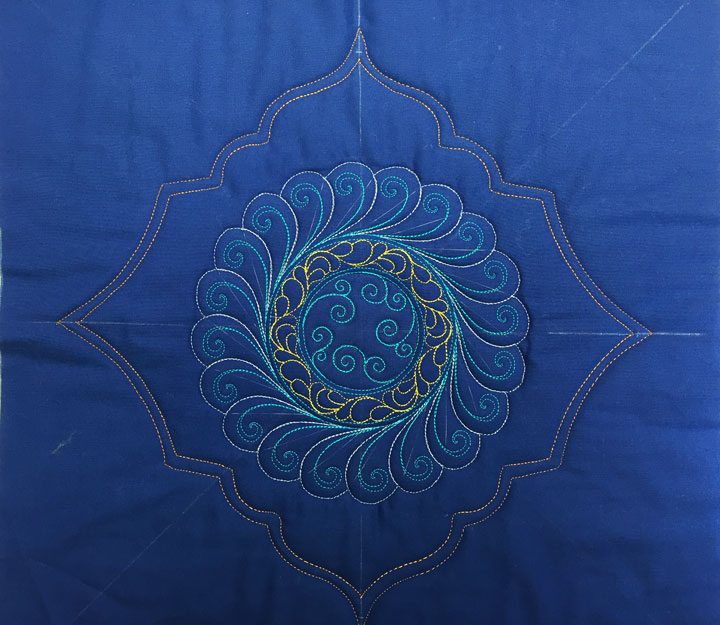 Now she’s starting to look a bit more interesting, and THAT is the power of channels! Remember my mantra, more channels=more intricacy=more interesting! Anyway, in this next shot, I’ve stitched another channel and begun to add some plumes around it. This is where my challenge came. This frame is symmetric from top to bottom as well as from 1 side to the other, but it is not 100% symmetric in all 4 quadrants. I needed to find a way to add my plumes in a flowing design that would maintain my “half-symmetry” state! As you look at the next shot, notice the new curved soap lines that flow in mirror image pairs from the frame. Creating curves like this, that can be followed as the plumes are added, is the secret here:
Now she’s starting to look a bit more interesting, and THAT is the power of channels! Remember my mantra, more channels=more intricacy=more interesting! Anyway, in this next shot, I’ve stitched another channel and begun to add some plumes around it. This is where my challenge came. This frame is symmetric from top to bottom as well as from 1 side to the other, but it is not 100% symmetric in all 4 quadrants. I needed to find a way to add my plumes in a flowing design that would maintain my “half-symmetry” state! As you look at the next shot, notice the new curved soap lines that flow in mirror image pairs from the frame. Creating curves like this, that can be followed as the plumes are added, is the secret here:
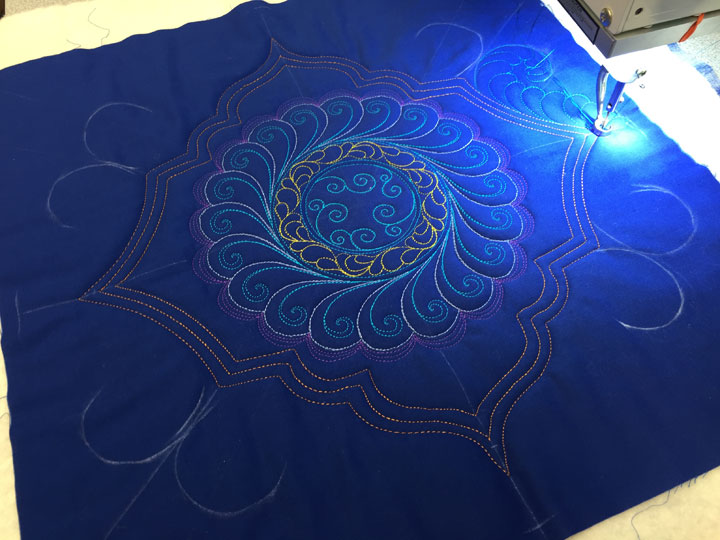 …and here is a closeup shot of the base frame once the plumes have been added to each side:
…and here is a closeup shot of the base frame once the plumes have been added to each side:
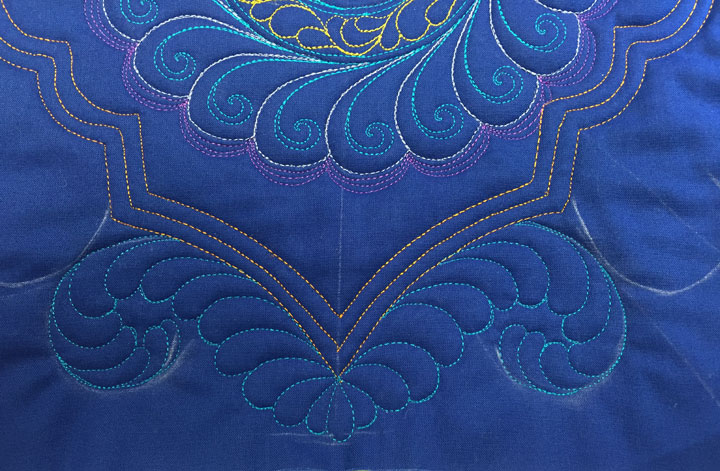 (You can see that I didn’t do a very good job of stitching those plumes as mirror images of one another from one side to the other, yet this will still come out looking pretty cool by the end!) And here is the frame once all plumes have been added:
(You can see that I didn’t do a very good job of stitching those plumes as mirror images of one another from one side to the other, yet this will still come out looking pretty cool by the end!) And here is the frame once all plumes have been added:
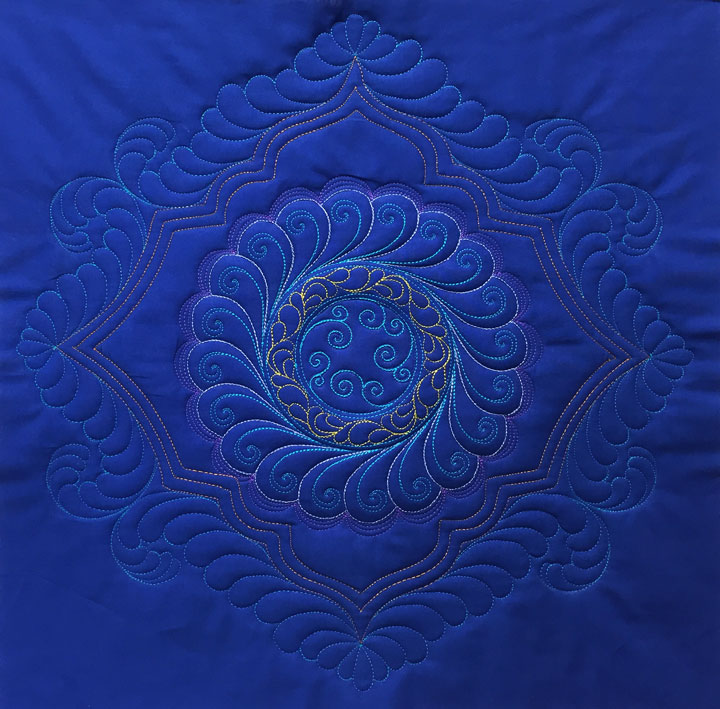 I felt like I needed to accentuate the edges of the frame so I added pebbles around the edge in a highly contrasting color:
I felt like I needed to accentuate the edges of the frame so I added pebbles around the edge in a highly contrasting color:
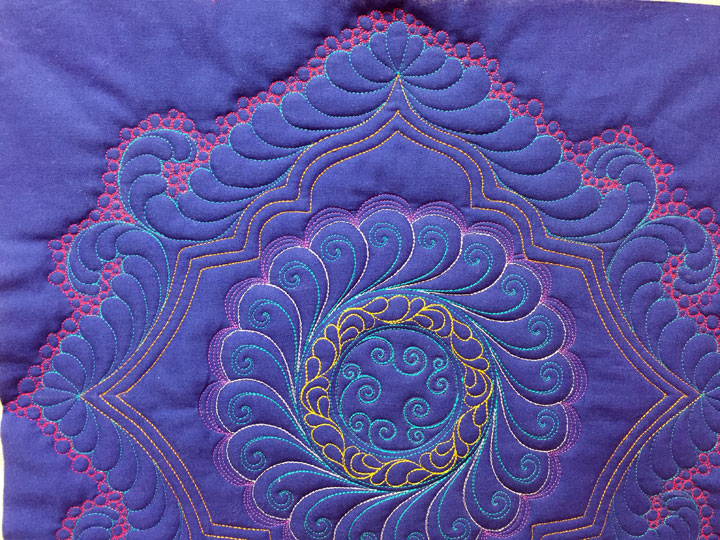 …and in the end, I added the fingertips design to fill the center zone by the wreath, and then added some doodly-quilting for the very outside:
…and in the end, I added the fingertips design to fill the center zone by the wreath, and then added some doodly-quilting for the very outside:
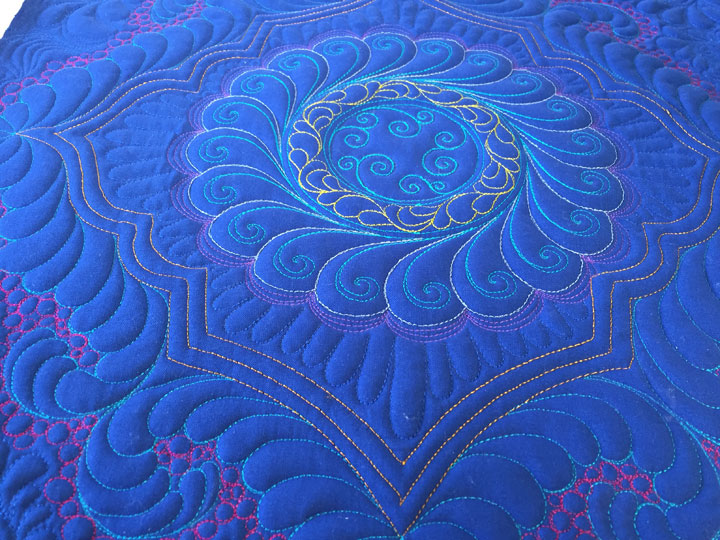 I’m linking up to Amy Johnson’s “Ruler Work Rocks Link-Up,” so get over there and link up your own post as well!!
I’m linking up to Amy Johnson’s “Ruler Work Rocks Link-Up,” so get over there and link up your own post as well!!

Filed under
Site Updates.
May 27th, 2015
 If you’re looking for some free quilting advice about quicker, more efficient ways of doing quilt-related tasks, organizing your studio, etc, check out this free downloadable pdf of quilting “know how” produced by the folks at Craftsy. You can find it by clicking here!
If you’re looking for some free quilting advice about quicker, more efficient ways of doing quilt-related tasks, organizing your studio, etc, check out this free downloadable pdf of quilting “know how” produced by the folks at Craftsy. You can find it by clicking here!
Filed under
Craftsy!, Site Updates.
May 19th, 2015
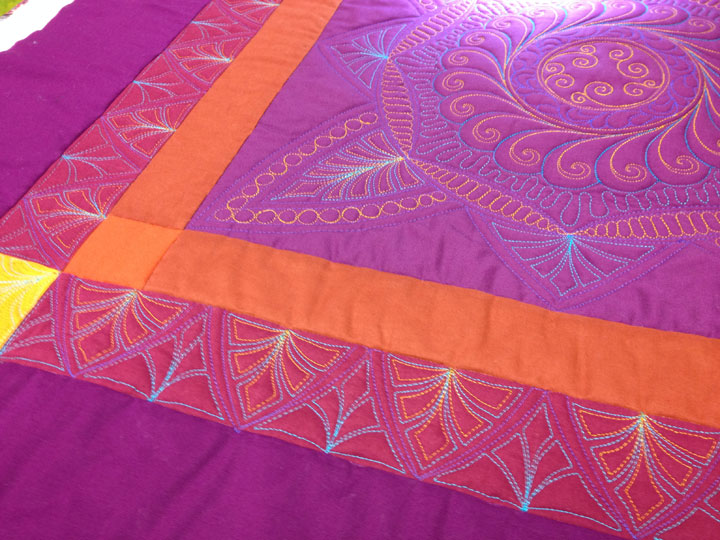 A couple of years ago, QuiltShopGal asked me to participate in her monthly Free Motion Quilting Challenge and I chose the topic of border designs. Until that year, the only interesting border designs I stitched were variations of feather designs. If I didn’t stitch a feather border, then my border designs were pretty lack-luster. Not so anymore! Border designs thrill me and I love the challenge of coming up with new border design ideas. The design above is a good example of the kind of design that evolves merely through playing around and improvising along the way. Sometimes, I will draw out a border design on scratch paper and sometimes I will stitch out a small sample on a throw away practice sandwich. The design above is an example of just “winging it” on a real quilt and I love how it came out! If you want to try something like this, here are the steps I went through to make the above border.
Step 1: Create the skeleton or frame work using ruler work. For this, I used the #12 arc ruler from the medium set of Quilters Groove Rulers by Stone House Quilting and you can find them by clicking here. In truth, you don’t need that exact ruler, and any softly curved arc ruler will do just fine. (Note: when you’re working w/arc rulers, the curve will become softer, or more subtle, as you increase the size of the ruler.) I placed small tick marks along the base of my border for where I wanted each arc to begin and end, and placed a corresponding tic mark in the midpoint of the space on the opposite side of the border. You can see in the photo below that I elongated every other tic mark so it was easy to see where I wanted the “peaks” of my archways:
A couple of years ago, QuiltShopGal asked me to participate in her monthly Free Motion Quilting Challenge and I chose the topic of border designs. Until that year, the only interesting border designs I stitched were variations of feather designs. If I didn’t stitch a feather border, then my border designs were pretty lack-luster. Not so anymore! Border designs thrill me and I love the challenge of coming up with new border design ideas. The design above is a good example of the kind of design that evolves merely through playing around and improvising along the way. Sometimes, I will draw out a border design on scratch paper and sometimes I will stitch out a small sample on a throw away practice sandwich. The design above is an example of just “winging it” on a real quilt and I love how it came out! If you want to try something like this, here are the steps I went through to make the above border.
Step 1: Create the skeleton or frame work using ruler work. For this, I used the #12 arc ruler from the medium set of Quilters Groove Rulers by Stone House Quilting and you can find them by clicking here. In truth, you don’t need that exact ruler, and any softly curved arc ruler will do just fine. (Note: when you’re working w/arc rulers, the curve will become softer, or more subtle, as you increase the size of the ruler.) I placed small tick marks along the base of my border for where I wanted each arc to begin and end, and placed a corresponding tic mark in the midpoint of the space on the opposite side of the border. You can see in the photo below that I elongated every other tic mark so it was easy to see where I wanted the “peaks” of my archways:
 Using the tick marks as my guide, I stitched out a long row of single-line arches, then went back and stitched a small, tapering channel between them. This is very fast and easy to do as ruler work. The thread I used for this stage was a purple polyester Isacord thread:
Using the tick marks as my guide, I stitched out a long row of single-line arches, then went back and stitched a small, tapering channel between them. This is very fast and easy to do as ruler work. The thread I used for this stage was a purple polyester Isacord thread:
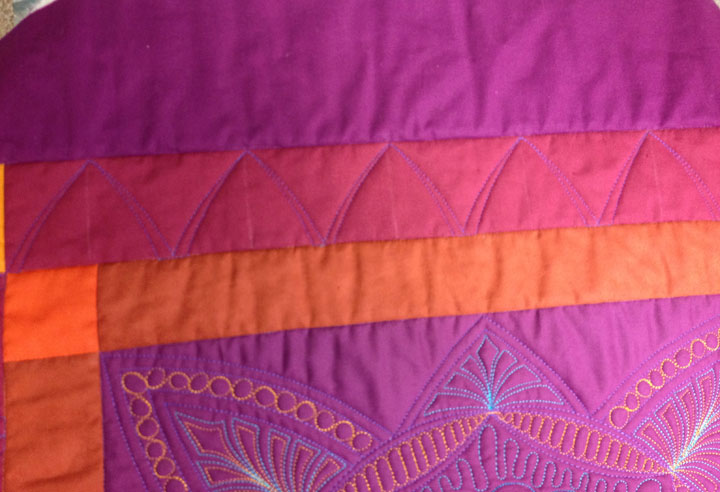 Step 2: Begin filling in your framework. For me, this next part is where it gets really fun. I think it’s all the time I’ve spent hyperquilting, but I just love coming up with “fill-in” designs. I’m going to show you a couple of options for fill in work. In the photo below, I stitched small cut-off feathers that make me think of Aztec designs. I used them because I was trying to echo some of the same types of designs I had stitched in that center block and I used a Sulky turquoise rayon thread for this step:
Step 2: Begin filling in your framework. For me, this next part is where it gets really fun. I think it’s all the time I’ve spent hyperquilting, but I just love coming up with “fill-in” designs. I’m going to show you a couple of options for fill in work. In the photo below, I stitched small cut-off feathers that make me think of Aztec designs. I used them because I was trying to echo some of the same types of designs I had stitched in that center block and I used a Sulky turquoise rayon thread for this step:
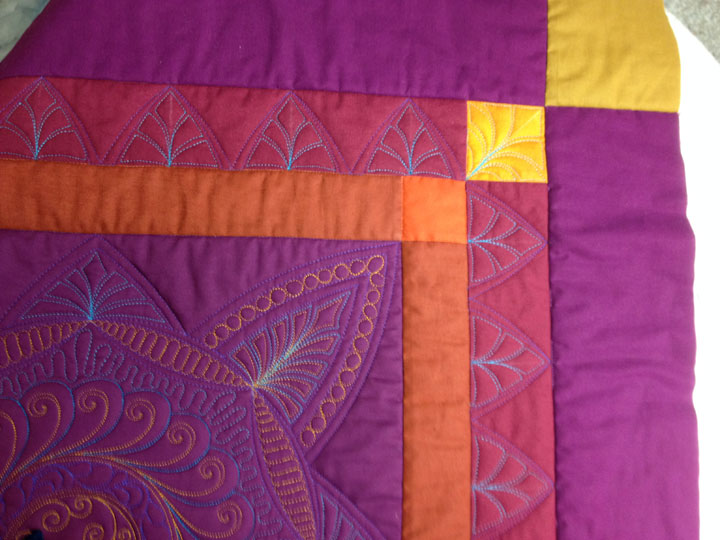 Interesting, but also a little boring! (Before I go any further, note that I stitched some “Aztec” designs in the cornerstone blocks at this stage as well.) Here’s where you can go in a couple of directions. In this next shot you’ll see what it looked like after stitching a similar (yet a teensy bit different) in the opposite arches from the opposite side of the border. I used the same turquoise rayon thread for this round of stitching:
Interesting, but also a little boring! (Before I go any further, note that I stitched some “Aztec” designs in the cornerstone blocks at this stage as well.) Here’s where you can go in a couple of directions. In this next shot you’ll see what it looked like after stitching a similar (yet a teensy bit different) in the opposite arches from the opposite side of the border. I used the same turquoise rayon thread for this round of stitching:
 Stitching these “Aztec feathers” is actually pretty simple. I began with a long soap line down the center of the arch, and this served as my “spine guideline.” If you approach it as if you’re stitching a regular feather but simply cut-off the rounded plume tips, you’re good to go. The goal is to completely fill the space w/the feather, so stretch out where you need to and contract where you need to, just as you would with a more traditional feather.
Step 3: Hyperquilt those Aztec feathers. The nice thing about borders is that there are 4 sides. This means that if you’re like me and you enjoy playing around with different design ideas, you can be doing different things on different sides of the same border to get an idea of “what if?” So, I’m hoping that I’m not confusing you, but here’s what the original border design would have looked like if I left it as arcs on just one side but then went in and hyperquilted the Aztec designs. I used Floriani gold polyester thread for this round of stitching:
Stitching these “Aztec feathers” is actually pretty simple. I began with a long soap line down the center of the arch, and this served as my “spine guideline.” If you approach it as if you’re stitching a regular feather but simply cut-off the rounded plume tips, you’re good to go. The goal is to completely fill the space w/the feather, so stretch out where you need to and contract where you need to, just as you would with a more traditional feather.
Step 3: Hyperquilt those Aztec feathers. The nice thing about borders is that there are 4 sides. This means that if you’re like me and you enjoy playing around with different design ideas, you can be doing different things on different sides of the same border to get an idea of “what if?” So, I’m hoping that I’m not confusing you, but here’s what the original border design would have looked like if I left it as arcs on just one side but then went in and hyperquilted the Aztec designs. I used Floriani gold polyester thread for this round of stitching:
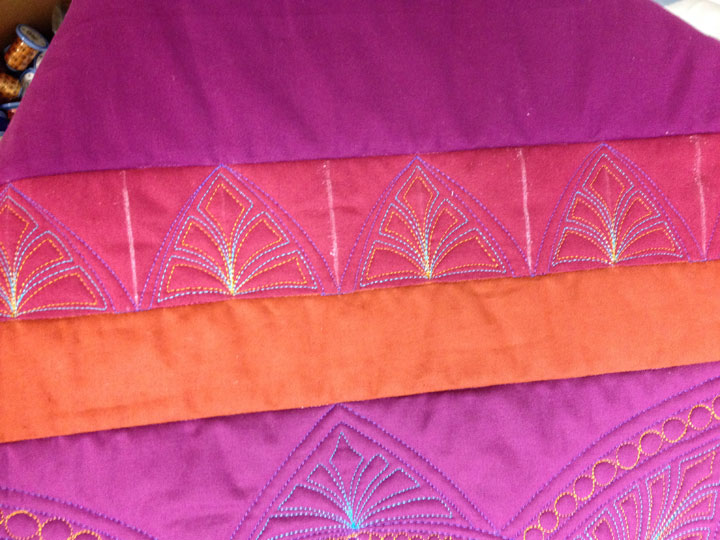 Isn’t it nice to see different options? My final border was hyperquilting the one side of the arches but adding the turquoise Aztec designs to both sides of the arches as in this shot below:
Isn’t it nice to see different options? My final border was hyperquilting the one side of the arches but adding the turquoise Aztec designs to both sides of the arches as in this shot below:
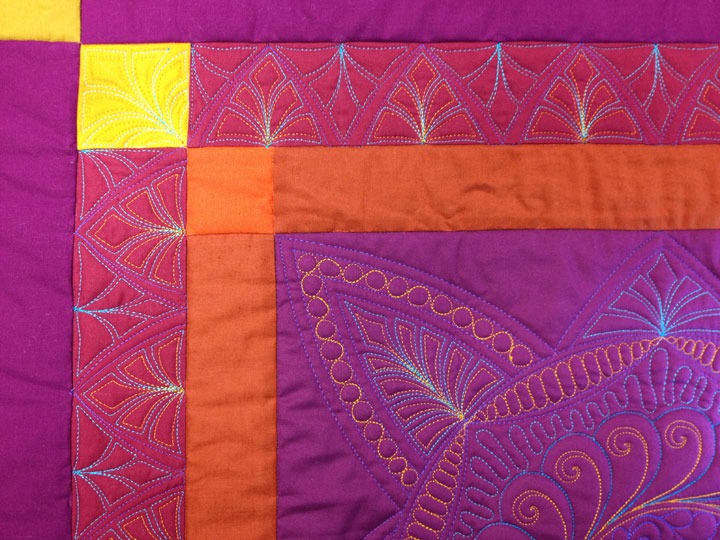 Could you hyperquilt both sides of the arches? Of course! In this case, I was hoping to accentuate that the arches and feathers on either side were actually a bit different from one another, so I left the hyperquilting off. I don’t think there’s a right/wrong way to do this.
I know I’ve said it before but it bears repeating. If you’re interested in learning about using ruler work as a sit-down quilter on your home sewing machine, you really need to start reading Amy Johnson’s blog which you can find by clicking here. It is a wonderful free motion quilting blog and it’s “the place to go” if your goal is to learn about ruler work on your home machine or on any sit-down machine. She explains things in a very easy-to-understand kind of way and she always has good illustrations, so head on over there now! In the mean time, I promise at least 3 blog posts in the next week. I haven’t been neglecting this blog on purpose, my life has just become too hectic lately. If you took the time to read this post, though, check back as I really do promise some more posts this week!
Could you hyperquilt both sides of the arches? Of course! In this case, I was hoping to accentuate that the arches and feathers on either side were actually a bit different from one another, so I left the hyperquilting off. I don’t think there’s a right/wrong way to do this.
I know I’ve said it before but it bears repeating. If you’re interested in learning about using ruler work as a sit-down quilter on your home sewing machine, you really need to start reading Amy Johnson’s blog which you can find by clicking here. It is a wonderful free motion quilting blog and it’s “the place to go” if your goal is to learn about ruler work on your home machine or on any sit-down machine. She explains things in a very easy-to-understand kind of way and she always has good illustrations, so head on over there now! In the mean time, I promise at least 3 blog posts in the next week. I haven’t been neglecting this blog on purpose, my life has just become too hectic lately. If you took the time to read this post, though, check back as I really do promise some more posts this week!

Filed under
Site Updates.
January 22nd, 2015

Wow…when it rains, it pours! I got a nice email today from Debbie Wassenaar of thequiltjournal.com blog and she has been using yet another ruler foot on her Babylock Ellisimo! She is using an open toe ruler foot but the opening is on the left side. I’m going to assume that this foot was designed for use on a frame system (hence the odd positioning of the opening on the foot) but it will still work for the sit-down quilter. Again, we are all out there in the same boat, searching for ruler foot options until our sewing machine manufacturers catch up with us, so this is another option if you are still in search of a foot. You can find her blog post about the foot (with a photo so you can see it) by clicking here and you can purchase the same foot on ebay. Thanks for passing along this info, Debbie! (You should probably bookmark her blog url since she’s posting some great info about free motion quilting!)
Filed under
Site Updates.
 I’ve done previous blog posts about creating fancy frame designs but this one is a bit different. In this case, I created a curvy/wurvy frame using ruler work, and then I embellished it heavily with plumes. My photos did not come out so great, but they are all that I have to illustrate the process, so we’re going to need to make do. This is the final piece:
I’ve done previous blog posts about creating fancy frame designs but this one is a bit different. In this case, I created a curvy/wurvy frame using ruler work, and then I embellished it heavily with plumes. My photos did not come out so great, but they are all that I have to illustrate the process, so we’re going to need to make do. This is the final piece:
 To make a fancy frame for the feathered wreath, I started with the Turrets 3 ruler. I’ll be blogging more about turret rulers, but they are basically a family of rulers that were designed primarily to create really beautiful swag border types of designs, but they also work great for creating fancy frames. Here is a shot of what the Turrets 3 ruler that I used for this design looks like:
To make a fancy frame for the feathered wreath, I started with the Turrets 3 ruler. I’ll be blogging more about turret rulers, but they are basically a family of rulers that were designed primarily to create really beautiful swag border types of designs, but they also work great for creating fancy frames. Here is a shot of what the Turrets 3 ruler that I used for this design looks like:
 (I’m hoping to have these available in the store in the next week or so, but we’ve gotten kind of distracted by some family emergencies, so we’ll see.) The left and right sides of the ruler are essentially “positive” and “negative” cutouts of the same shape. The ruler has etched lines so you can create a series of channels and there are other series of lines that allow you to accurately “keep your place” when you move the ruler to stitch the opposite side of the swag or frame. Anyway, this next photo shows the most basic “bones” of the frame stitched around the wreath:
(I’m hoping to have these available in the store in the next week or so, but we’ve gotten kind of distracted by some family emergencies, so we’ll see.) The left and right sides of the ruler are essentially “positive” and “negative” cutouts of the same shape. The ruler has etched lines so you can create a series of channels and there are other series of lines that allow you to accurately “keep your place” when you move the ruler to stitch the opposite side of the swag or frame. Anyway, this next photo shows the most basic “bones” of the frame stitched around the wreath:
 Not really much to write home about yet, is there? (Notice also that I have my famous soap lines dividing up the block. I pretty much always have all of them there, even though I may not use all of them. It just helps me keep my options option.) Next up is the frame once I’ve stitched an echo line to create the first channel:
Not really much to write home about yet, is there? (Notice also that I have my famous soap lines dividing up the block. I pretty much always have all of them there, even though I may not use all of them. It just helps me keep my options option.) Next up is the frame once I’ve stitched an echo line to create the first channel:
 Now she’s starting to look a bit more interesting, and THAT is the power of channels! Remember my mantra, more channels=more intricacy=more interesting! Anyway, in this next shot, I’ve stitched another channel and begun to add some plumes around it. This is where my challenge came. This frame is symmetric from top to bottom as well as from 1 side to the other, but it is not 100% symmetric in all 4 quadrants. I needed to find a way to add my plumes in a flowing design that would maintain my “half-symmetry” state! As you look at the next shot, notice the new curved soap lines that flow in mirror image pairs from the frame. Creating curves like this, that can be followed as the plumes are added, is the secret here:
Now she’s starting to look a bit more interesting, and THAT is the power of channels! Remember my mantra, more channels=more intricacy=more interesting! Anyway, in this next shot, I’ve stitched another channel and begun to add some plumes around it. This is where my challenge came. This frame is symmetric from top to bottom as well as from 1 side to the other, but it is not 100% symmetric in all 4 quadrants. I needed to find a way to add my plumes in a flowing design that would maintain my “half-symmetry” state! As you look at the next shot, notice the new curved soap lines that flow in mirror image pairs from the frame. Creating curves like this, that can be followed as the plumes are added, is the secret here:
 …and here is a closeup shot of the base frame once the plumes have been added to each side:
…and here is a closeup shot of the base frame once the plumes have been added to each side:
 (You can see that I didn’t do a very good job of stitching those plumes as mirror images of one another from one side to the other, yet this will still come out looking pretty cool by the end!) And here is the frame once all plumes have been added:
(You can see that I didn’t do a very good job of stitching those plumes as mirror images of one another from one side to the other, yet this will still come out looking pretty cool by the end!) And here is the frame once all plumes have been added:
 I felt like I needed to accentuate the edges of the frame so I added pebbles around the edge in a highly contrasting color:
I felt like I needed to accentuate the edges of the frame so I added pebbles around the edge in a highly contrasting color:
 …and in the end, I added the fingertips design to fill the center zone by the wreath, and then added some doodly-quilting for the very outside:
…and in the end, I added the fingertips design to fill the center zone by the wreath, and then added some doodly-quilting for the very outside:
 I’m linking up to Amy Johnson’s “Ruler Work Rocks Link-Up,” so get over there and link up your own post as well!!
I’m linking up to Amy Johnson’s “Ruler Work Rocks Link-Up,” so get over there and link up your own post as well!!
















